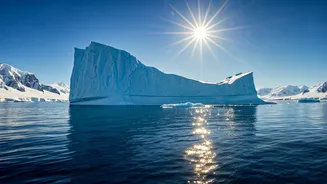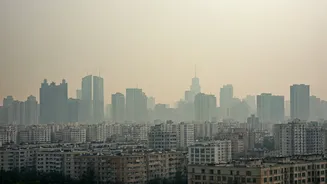Melting at Pace
The Antarctic ice sheet, a massive reservoir of frozen freshwater, is melting at an accelerated pace. Scientists have observed a clear trend of increased
ice loss over the past few decades, a trend that is showing no signs of slowing down. This increased melting is primarily due to rising global temperatures, a direct consequence of human activities, such as burning fossil fuels. Warming air temperatures directly contribute to ice melt, while warmer ocean waters erode the ice shelves from below. The extent of melting is so significant that it is contributing substantially to global sea-level rise, threatening coastal communities and ecosystems around the world. Recent studies have found that multiple regions of the Antarctic are experiencing accelerated melting, with the West Antarctic ice sheet being particularly vulnerable. The loss of ice also disrupts ocean currents and alters global weather patterns, leading to more extreme and unpredictable weather events worldwide. The rate of melting is a critical indicator of the overall health of the planet and a warning signal for future environmental impacts.
Tipping Point Threats
The scientific community is warning that Antarctica is approaching, or may have already passed, critical climate tipping points. These tipping points represent thresholds beyond which significant and irreversible changes to the Antarctic ice sheet could occur. One significant concern is the potential collapse of the West Antarctic ice sheet. Once the ice sheet begins to collapse, the process could become self-sustaining, leading to a rapid and substantial rise in sea levels. Another major concern involves the Thwaites Glacier, often called the 'Doomsday Glacier.' This glacier is particularly vulnerable and its complete disintegration could alone raise global sea levels by several feet. Crossing these tipping points implies that even if global greenhouse gas emissions were to cease immediately, the changes in the Antarctic environment would continue for centuries. This includes further loss of ice, accelerated sea-level rise, and more pronounced climate disruptions worldwide. The identification of and monitoring for these tipping points are crucial for assessing the long-term impact of climate change.
Consequences Loom
The accelerating melting of the Antarctic ice sheet has far-reaching consequences that will affect the entire planet. One of the most immediate impacts is the rise in global sea levels. As ice melts and flows into the ocean, sea levels rise, threatening coastal regions. Low-lying areas could be submerged, displacing millions of people and causing significant economic damage. Beyond sea-level rise, the loss of ice also has ramifications for the Earth's climate system. The melting ice reduces the planet's albedo, which is the ability of the Earth to reflect sunlight back into space. Less ice means that the planet absorbs more solar radiation, leading to further warming and accelerating the melting process in a dangerous positive feedback loop. Changes in ocean currents, driven by the influx of freshwater from melting ice, could also disrupt global weather patterns, leading to more frequent and intense storms, droughts, and other extreme weather events around the world. The effects of the melting Antarctic ice could include disruptions to agriculture, increased food insecurity, and widespread displacement of populations.
Urgent Action Needed
Scientists and policymakers worldwide recognize the urgent need for action to mitigate the impacts of Antarctic ice melt. The most critical step is to reduce greenhouse gas emissions by transitioning away from fossil fuels and embracing renewable energy sources. This transition must be swift and decisive to limit the increase in global temperatures and reduce the rate of ice loss. Alongside emission reductions, adaptation measures are also necessary to cope with the effects of climate change already underway. These measures include investing in coastal defenses to protect communities from rising sea levels, developing drought-resistant crops, and implementing early warning systems for extreme weather events. International collaboration is critical. Agreements and treaties like the Paris Agreement provide a framework for global cooperation on climate action, but these agreements must be strengthened and enforced to achieve meaningful change. Further research into Antarctic ice dynamics is also essential to improve climate models and refine our understanding of the impacts of climate change. Only concerted global effort will slow the melting and protect the planet.
















